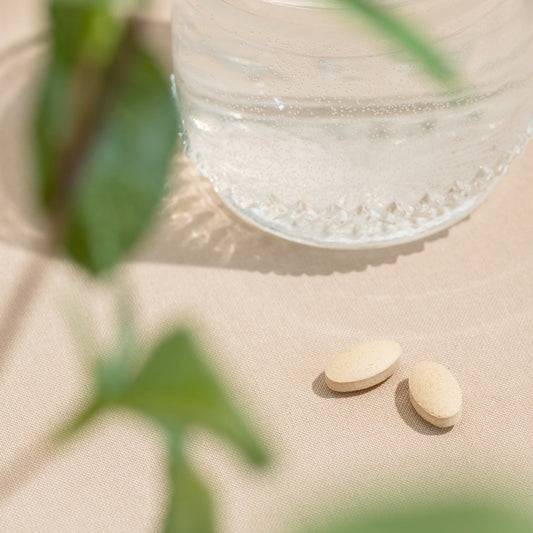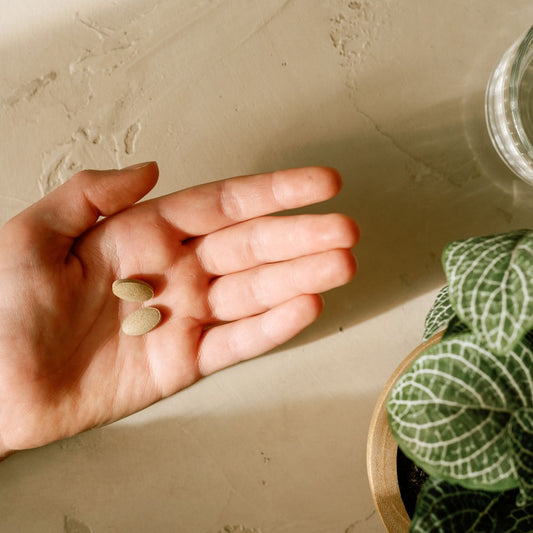Adaptation. Without this remarkable quality, life as we know it would not exist. It is only through the ability to adapt that humans, plants, and animals have evolved to their modern-day capacity.
There is a fascinating concept at play here, and that is the fact that plants have actually helped us to adapt to our changing environments and circumstances. Plants have helped us cope with—and become more resilient to—the stressors in our lives. These types of plants have come to be known as adaptogens.
What Are Adaptogenic Herbs?
What are adaptogens? While these plants have been around and in use for thousands, if not millions of years, it wasn't until the mid-20th century that a Russian scientist first proposed the term adaptogens.1 Today, an adaptogen can be defined as an agent that:
- Has a normalizing effect on a wide range of bodily functions
- Has a nonspecific action that helps the body overcome stress regardless of the direction of stress
- Is nontoxic when used in normal dosage2
In other words, adaptogens help modify the body's reaction to stress, both environmental and internal. One way they do this is by strengthening and supporting the immune, nervous, and glandular systems.3
There is a compelling fact about adaptogenic plants—they themselves often live in stressful conditions and have their own adaptation strengths and abilities, which they impart to us. For example, ashwagandha, a popular adaptogen in Ayurveda, is highly drought-resistant and flourishes in arid conditions and soil of poor quality, conditions in which most plants would suffer from severe stress.4
Adaptogen Sciences
It cannot be overstated that for millennia humans have depended upon plants as both food and medicine. Since their inception, both Chinese medicine and Ayurveda have relied on herbal remedies for healing and rejuvenation. However, in the West, much of plants' wisdom and efficacy has been limited or even relegated to folklore, indigenous communities, and countries outside of the United States.
This was also true in the world of research. Until recently, much of the research on adaptogens was largely confined to Asian countries and received little interest (if any) from the West. Luckily, we're seeing this change as adaptogenic herbs become more widely known and used across the globe.
In Medical Herbalism, David Hoffman notes that the science around adaptogenic mechanisms supports their relationship to the “pituitary-adrenal gland axis” and that “their ability to 'smooth out' the body's stress response may be related to adaptogen's effects on glucose metabolism…[however] the specific mechanism of adaptogenic activity has not yet been elucidated.”5 We may be able to surmise that by supporting the adrenal glands, adaptogens also support the regulation of stress hormones, including cortisol.
As noted on Healthline, new research is looking at how these wonder-herbs may be helpful in supporting a wide spectrum of our health, including the respiratory system and the heart.6
Another important aspect of adaptogens, as their name connotes, is their ability to adjust to a body's needs, bringing the body back into balance “no matter what the direction of imbalance."7 Ashwagandha is a great example of this phenomenon as it has the ability to both support healthy energy and vitality while also soothing the mind and helping to maintain restful sleep.8
Adaptogens from an Ayurvedic Lens
In Ayurveda, adaptogens can be compared to a similar category of herbs known as rasayanas. Rasayanas are a class of herbs that support overall health, longevity, and vitality. They are rejuvenating and revitalizing agents that help the body adapt to stressors, maintain resilience, and foster a balanced life. Rasayanas are an integral part of the Ayurvedic pharmacopeia and have been used for centuries to improve overall well-being.
Here are some key ways that adaptogens are comparable to Ayurvedic rasayanas. They:
- Balance the Doshas: Rasayanas are believed to help balance the doshas and restore balance.
- Enhance Vitality: Rasayanas are thought to promote vitality and strength by nourishing the body's tissues (dhatus) and supporting healthy energy levels.9
- Bolster a Healthy Immune System: Ayurvedic rasayanas are known for supporting healthy immune function. They are believed to bolster the body's natural defense mechanisms.10
- Promote Healthy Aging: Rasayanas are often associated with healthy aging. They are believed to maintain youthful vigor and support the natural process of aging. Some rasayanas are even known to rejuvenate the body and mind.11
- Support Stress Management: One of the primary functions of rasayanas is to help the body adapt to physical and mental stressors.
- Support Detoxification: Rasayanas are thought to assist in the natural cleansing of the body by removing accumulated toxins (ama) and supporting a healthy digestive system.

10 Popular Adaptogenic Herbs
The following list includes 10 well-known adaptogens from the Ayurvedic pharmacopeia and outlines their effects on the body:
- Amla. Amla (Embelica officinalis), also called amalaki, is known as “mother” or “nurse” in Sanskrit. It is known to be a superfood, as well as a natural source of antioxidants and vitamin C. It helps to nourish and rejuvenate the body's tissues while gently removing naturally built up toxins, supporting overall health and vitality as a result. In Ayurveda, amla is known to balance sadhaka pitta, thus influencing clarity and calmness of mind.12
- Ashwagandha. Ashwagandha (Withania somnifera) is also known as “Indian ginseng,” though it is not related to the ginseng family and most likely gets this name in reference to its energy supporting qualities.13 Somnifera is translated as “sleep-inducing,” reflecting its relaxing and calming properties that bring us energy by supporting deeper rest.
- Bacopa. Bacopa (Bacopa monnieri) is traditionally used to support healthy cognitive function, including memory, focus, and concentration. It is an excellent herb for balancing vata, easing tension, and supporting restful sleep, and is often paired with brahmi/gotu kola to magnify the cognitive-supporting properties of both herbs.14
- Gotu Kola. Gotu Kola (Centella asiatica) is an ancient rejuvenative whose name translates to “the energy of universal consciousness.” An ancient rejuvenative for the brain and nervous system, it is traditionally used to support concentration, memory, and alertness. In the body, brahmi nourishes majja dhatu, supporting a stable nervous system and helping the body cope with stress.15
- Guduchi. Guduchi (Tinospora cordifolia) is fondly called “the one who protects the body” and benefits the body in a variety of ways, especially in relation to conditions of aggravated pitta. It supports a healthy immune response, healthy liver function, and the elimination of natural toxins. It is calming to vata and the nervous system in general.16
- Licorice. Licorice (Glycyrrhiza glabra) benefits all seven tissue layers, or dhatus. It is calming and cooling for pitta while also nourishing for vata and kapha. Licorice has a special affinity for the lungs and mucous membranes. It acts as an adrenal tonic, thus supporting the body's stress response, and its sattvic nature is calming to the mind.17
- Moringa. Moringa (Moringa oleifera), largely due to its impressive nutrient content, is helpful for sleep, the heart, kidneys, liver, blood, and the pancreas.18 Moringa supports healthy energy levels and restoration of the body's tissues. For more information on moringa's nutrient content and superfood status, take a peek at the benefits of moringa.
- Tulsi or Holy Basil. Tulsi (Ocimum sanctum) is so highly revered that it has been referred to as “a goddess incarnated in plant form.”19 Tulsi is said to increase prana and awareness to support a calm, clear mind. It is beneficial for all three doshas, with a special affinity for the lungs and rasa dhatu.20 Research has found that tulsi helps protect the body from daily stress through healthy circulation and metobolic function. It was also known traditionally as a respiratory tonic.21
- Shatavari. Shatavari (Asparagus racemosus) is affectionately referred to as “the one who has 100 husbands.” It is to the female reproductive system as ashwagandha is to the male reproductive system, and is considered a rejuvenative as well as an adaptogen. It is a nutritive tonic, especially known for nourishing the tissues of the lungs, stomach, kidneys, and reproductive organs.22
- Shilajit. Technically not an herb, shilajit is an adaptogenic mineral pitch found in the harsh conditions of the Himalayas. Its high mineral content makes it beneficial for many of the body's tissues, especially the the urinary tract and reproductive systems.23 It is traditionally known to balance all doshas and promote healthy aging.

4 Noteworthy “False” Adaptogens (Adaptogen-Like Herbs)
In addition to the herbs that have been officially labeled as adaptogens, there are many other plants that share similar qualities or lead to similar health-promoting outcomes.
Even without being adopted into the official adaptogen “club,” these herbs still have a lot to offer.
The following list of “false” adaptogens includes herbs that support resilience in the body and mind by way of other pathways, such as promoting overall balance, a healthy immune system, and a healthy nervous system.
- Mucuna. As a natural source of L-dopa, a precursor to dopamine, mucuna (Mucuna pruriens) has a special affinity for the nervous system. Also known as kapikacchu, this herb is both strengthening and calming, and it is considered one of the best tonics for the supporting a healthy reproductive system.24
- Milk Thistle. Milk thistle (Silybum marianum) is best known for its capacity to support a healthy liver. Considered a rasayana in Ayurveda25, this plant is known to have a nourishing and rejuvenating effect. At the same time, its gentle cleansing action helps to remove the toxins that add stress to the body—supporting overall health and resilience throughout the system.
- Elderberry. Elderberries (Sambucus nigra) are known for their rich phytochemistry and naturally occurring bioactive compounds, which exhibit beneficial antioxidant properties. Commonly used to support a healthy immune system and a healthy respiratory tract, elderberry contributes to the body's overall balance in the face of stress.*
- Turmeric. Turmeric (Curcuma longa) is another well-known and highly revered herb that is not officially considered an adaptogen. But thanks to its wide range of health benefits, including supporting a healthy inflammatory response, balanced digestion, and overall health, it is sometimes honored as a secondary or supporting adaptogen.26
How to Take Adaptogens
Traditionally, bulk herbs are taken as a tea. Most herbs have a synergistic effect when taken with other herbs and thus are usually taken in tandem.
However, preparing herbs in this way each day does not fit into everyone's routine. With this in mind, Banyan conveniently offers many of our single herbs in tablet form, including amla, ashwagandha, gotu kola, mucuna, shatavari, and tulsi.
Taking these supplements is simple. For tablets, we generally recommend 1–2 tablets, once or twice daily. All bodies are different and respond to herbs differently, so if you're interested in more specific guidance, we recommend working with a practitioner.

Adaptogenic Supplements
Banyan Botanicals has listened to Ayurvedic wisdom and the science of adaptogens to create some truly supportive adaptogenic blends. Here are a few of our favorites:
- Everyday Endurance brings together top Ayurvedic adaptogens and herbal superfoods in one power-packed blend to optimize physical energy, stamina, and vitality. Designed for athletes, those with an active lifestyle, and anyone seeking a natural approach to abundant energy.
- Chyavanprash is a traditional Ayurvedic rejuvenative jam. Some of its herbal adaptogens include amla, ashwagandha, and guduchi. Along with other warming and nourishing herbs, this formula is known for its energizing and immune-boosting effects.
- 7-Herb Energy liquid extract is a natural and caffeine-free blend of adaptogens including ashwagandha, Asian ginseng, eleuthero, gotu kola, and licorice. All of these offer stress relief and act as a pure, herbal pick-me-up.
- Stress Ease, as its name imparts, is specially formulated to aid in times of elevated stress. Drawing from the strength of several essential adaptogens, this blend offers reinforcement to both the body and the mind.
- Adrenal Nourish is packed with adaptogens to help the body cope with stress and maintain balanced energy. It also supports the optimal function of the adrenals and nourishes the whole endocrine system.
- Elderberry Honey is crafted with bee-friendly Hawaiian honey and naturally packed with antioxidant-rich superfoods, including elderberry and amla. Perfect for kids and adults alike, it supports the healthy function of the immune system and a healthy respiratory tract.
- Shakti Prana is a rejuvenating blend of ghee, honey, and herbal superfoods formulated by Ayurvedic physician Vasant Lad. Packed with nourishment, this thick and hearty herbal blend supports balanced energy and replenishes vitality.
Are Adaptogens Safe?
In One Earth Herbal Sourcebook, Dr. Tillotson classifies herbs that score high in terms of both safety and effectiveness for general daily use as “gold standard” herbs. He states that few herbs actually meet this “highest” standard.27 Some adaptogens that are given a gold standard include amla, ashwagandha, brahmi/gotu kola, and guduchi.
While most herbs are generally recognized as safe, they may also come with their own limitations. Diuretic herbs, for example, need to be taken with care. We always recommend working with a trained professional or at least doing some preliminary research before starting a new herbal routine.
Keep in mind that although an herb may be considered safe, it does not necessarily mean that it is the right herb for you. There are also health conditions and certain phases of life, such as pregnancy, that need to be taken into consideration when choosing an herbal protocol.
Get to know these wonderful adaptogenic herbs of Ayurveda and start incorporating them into your life as feels appropriate. Notice the help they provide and make adjustments along the way. For more information about choosing the right herbs for you and developing a relationship with these traditional plants, we suggest reading more about Taking Your Herbs.










